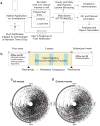A Smartphone App Reveals Erratic Diurnal Eating Patterns in Humans that Can Be Modulated for Health Benefits
- PMID: 26411343
- PMCID: PMC4635036
- DOI: 10.1016/j.cmet.2015.09.005
A Smartphone App Reveals Erratic Diurnal Eating Patterns in Humans that Can Be Modulated for Health Benefits
Abstract
A diurnal rhythm of eating-fasting promotes health, but the eating pattern of humans is rarely assessed. Using a mobile app, we monitored ingestion events in healthy adults with no shift-work for several days. Most subjects ate frequently and erratically throughout wakeful hours, and overnight fasting duration paralleled time in bed. There was a bias toward eating late, with an estimated <25% of calories being consumed before noon and >35% after 6 p.m. "Metabolic jetlag" resulting from weekday/weekend variation in eating pattern akin to travel across time zones was prevalent. The daily intake duration (95% interval) exceeded 14.75 hr for half of the cohort. When overweight individuals with >14 hr eating duration ate for only 10-11 hr daily for 16 weeks assisted by a data visualization (raster plot of dietary intake pattern, "feedogram") that we developed, they reduced body weight, reported being energetic, and improved sleep. Benefits persisted for a year.
Copyright © 2015 Elsevier Inc. All rights reserved.
Figures





References
-
- Asher G, Schibler U. Crosstalk between components of circadian and metabolic cycles in mammals. Cell metabolism. 2011;13:125–137. - PubMed
-
- Bauer UE, Briss PA, Goodman RA, Bowman BA. Prevention of chronic disease in the 21st century: elimination of the leading preventable causes of premature death and disability in the USA. Lancet. 2014;384:45–52. - PubMed
-
- Blood ML, Sack RL, Percy DC, Pen JC. A comparison of sleep detection by wrist actigraphy, behavioral response, and polysomnography. Sleep. 1997;20:388–395. - PubMed
-
- Cappuccio FP, Cooper D, D’Elia L, Strazzullo P, Miller MA. Sleep duration predicts cardiovascular outcomes: a systematic review and meta-analysis of prospective studies. European heart journal. 2011;32:1484–1492. - PubMed
Publication types
MeSH terms
Grants and funding
LinkOut - more resources
Full Text Sources
Other Literature Sources
Medical
Research Materials

